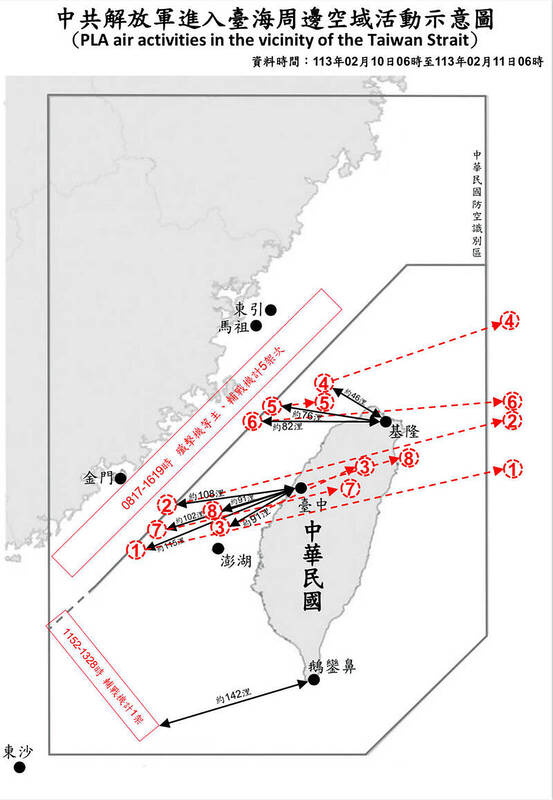A record six Chinese balloons flew across Taiwan between 6am on Saturday and 6am yesterday, the Ministry of National Defense (MND) said.
In its daily report on Chinese military activities, the ministry said that the six balloons were among eight that crossed the median line of the Taiwan Strait during the 24-hour period.
The eight balloons were detected between 10:05am and 3:34pm on Saturday at altitudes of 3,658m to 10,668m, it said.

Photo courtesy of the Ministry of National Defense
Of the six that crossed Taiwan, some flew over Keelung in the north, while the others flew near Taichung, it added.
The ministry did not comment on the type of balloons involved or say why Beijing had sent them across the median line.
The median line in the Taiwan Strait served for decades as a tacit border, but the Chinese military has sent more aircraft, warships and drones across it since then-US House of Representatives speaker Nancy Pelosi visited Taiwan in August 2022.
Saturday and yesterday marked the first day and second day of the new lunar year, which is celebrated on both sides of the Taiwan Strait, as well as by Chinese communities across the globe.
A military spokesman last month said that the daily sending of balloons to Taiwan was part of Chinese “gray zone” tactics in the run-up to the presidential and legislative elections on Jan. 13 and meant to “harass and rattle Taiwanese.”
The military has generally assessed the balloons as being for meteorological purposes, a conclusion drawn in part from its investigation of balloon debris found in February last year around Dongyin Island (東引).
The ministry last year said that similar equipment had been regularly detected in the air and sea around Taiwan, most often between December and February, because seasonal winds bring the balloons closer to Taiwan.
Speaking at a press event on Jan. 9, Colonel Wang Chia-chun (王家駿), deputy head of ministry’s joint operations planning section, said that shooting down the balloons would be “a waste of ammunition” and the exact response China wants from Taiwan.
Taiwan’s standard military response is to issue alerts to the relevant authorities and to closely monitor the balloons’ movements, particularly if they are found to be flying near more densely populated areas, he added.

MISINFORMATION: The generated content tends to adopt China’s official stance, such as ‘Taiwan is currently governed by the Chinese central government,’ the NSB said Five China-developed artificial intelligence (AI) language models exhibit cybersecurity risks and content biases, an inspection conducted by the National Security Bureau (NSB) showed. The five AI tools are: DeepSeek, Doubao (豆包), Yiyan (文心一言), Tongyi (通義千問) and Yuanbao (騰訊元寶), the bureau said, advising people to remain vigilant to protect personal data privacy and corporate business secrets. The NSB said it, in accordance with the National Intelligence Services Act (國家情報工作法), has reviewed international cybersecurity reports and intelligence, and coordinated with the Ministry of Justice Investigation Bureau and the National Police Agency’s Criminal Investigation Bureau to conduct an inspection of China-made AI language

BOOST IN CONFIDENCE: The sale sends a clear message of support for Taiwan and dispels rumors that US President Donald Trump ‘sold out’ the nation, an expert said The US government on Thursday announced a possible sale to Taiwan of fighter jet parts, which was estimated to cost about US$330 million, in a move that an expert said “sends a clear message of support for Taiwan” amid fears that Washington might be wavering in its attitude toward Taipei. It was the first announcement of an arms sale to Taiwan since US President Donald Trump returned to the White House earlier this year. The proposed package includes non-standard components, spare and repair parts, consumables and accessories, as well repair and return support for the F-16, C-130 and Indigenous Defense Fighter aircraft,

CHECKING BOUNDARIES: China wants to disrupt solidarity among democracies and test their red lines, but it is instead pushing nations to become more united, an expert said The US Department of State on Friday expressed deep concern over a Chinese public security agency’s investigation into Legislator Puma Shen (沈伯洋) for “secession.” “China’s actions threaten free speech and erode norms that have underpinned the cross-strait ‘status quo’ for decades,” a US Department of State spokesperson said. The Chongqing Municipal Public Security Bureau late last month listed Shen as “wanted” and launched an investigation into alleged “secession-related” criminal activities, including his founding of the Kuma Academy, a civil defense organization that prepares people for an invasion by China. The spokesperson said that the US was “deeply concerned” about the bureau investigating Shen

LIMITS: While China increases military pressure on Taiwan and expands its use of cognitive warfare, it is unwilling to target tech supply chains, the report said US and Taiwan military officials have warned that the Chinese People’s Liberation Army (PLA) could implement a blockade within “a matter of hours” and need only “minimal conversion time” prior to an attack on Taiwan, a report released on Tuesday by the US Senate’s China Economic and Security Review Commission said. “While there is no indication that China is planning an imminent attack, the United States and its allies and partners can no longer assume that a Taiwan contingency is a distant possibility for which they would have ample time to prepare,” it said. The commission made the comments in its annual